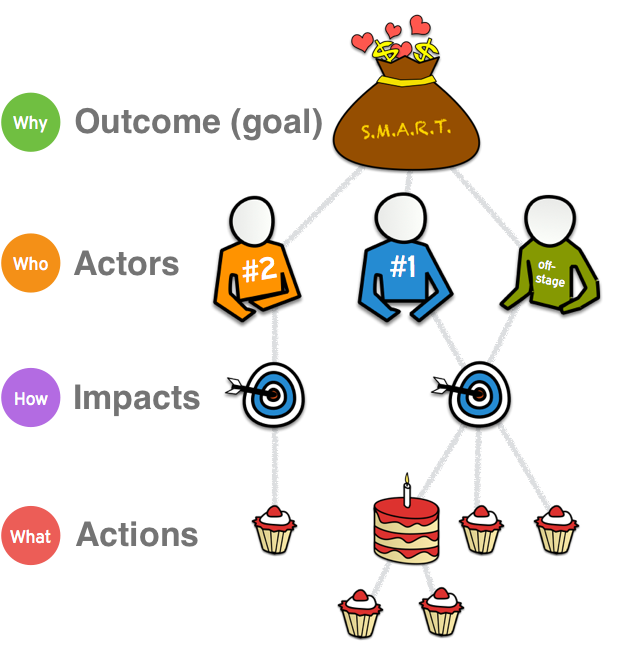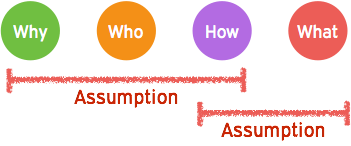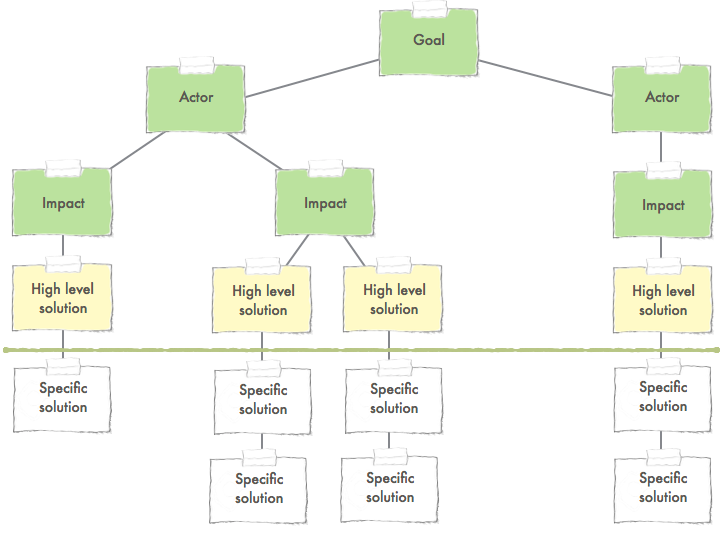Impact mapping is a way to start product development from the right direction and to keep an ongoing product strategy. Simplified, you ask four questions – Why will be doing product development? Who can help us reaching this goal? What needs to they have that we can fulfil so that we reach the goal? How are we going to fulfil their needs?
This stops us from just starting to build something. That something is rarely and only by pure luck a good product. And apart from that, creating a simple impact map together with team or even just showing it to the team increases the effectiveness of the team.
The method I call Impact Mapping and that I will describe below is based on a combination of Ingrid Domingues and Mijo Balic’s Effektkartläggning (or Business Impact Mapping in English and Gojko Adzic’s Impact Mapping. It also includes elements from Jeff Patton’s User Story Mapping.
Fulfilling needs and changing behaviours
The methods mentioned above are at first glance very similar, but there are a few things that sets them apart. My explanation of impact mapping below incorporates all these things, since there are positive aspects of them and good reasoning behind them.
Domingues and Balic’s Business Impact mapping is based on the belief that by fulfilling the needs and motivations specific users with certain actions, we can reach the intended effect, and we will best do so by mapping out all or most of these needs in detail so that we can prioritise easily.
Adzic’s Impact mapping is based on the belief that by forming or changing the behaviour of specific actors with certain actions, we can reach the intended goal, and we will best do so by mapping out only what’s needed at the moment to visualise assumptions quickly.

The impact map will help visualising the relationship between the delivery plan and the real world. This enables responding to change and helps us plan efficiently. The map also gives us transparency so that the developers would know what to do and the business side would know what’s being done.
Creating the map
The impact map is preferably created collaboratively so that it engages the very much needed conversation in all businesses about happy customers and fulfilled business needs. The best case would be that everyone who would be involved later to realise the map is present when creating the map.
When creating the map you should start with the goal that seems the most important, go on with the actors that seems the best to help you reach the goal, go with their main needs and behaviours, and the most focused and simple solutions for the needs and behaviours. When these are done, you can continue to explore the rest of the map in a similar fashion. You never build the whole map from the beginning, that is wasteful. The objective is to find the shortest route on the map to the most effective and efficient solution.
Nothing on the map is considered truth until we have validated it with actors and ourselves (such as actually having a goal that is supported by a well founded business case).

Outcomes and goals
Impact mapping is done from the top down. It is very common that one has an idea for a solution and no one has actually considered the problem or how to know when a possible problem is solved, before building that solution. To make sure we do not waste any time or effort, we start with a problem statement in the form of a goal. The question we should ask ourselves is Why are we doing this? and/or What is the outcome we want to achieve?.
The main reason for forming the answer to that question as an outcome is to be able to reevaluate the map we’ll be building as soon as we get new information, such as a change in the market, an invalidated assumption about our users or a possible new solution. Another reason is to focus the actual realisation of the solution on what needs to be done and remove all other waste, for instance feature ideas that pop up during development because they are easy to do, would look cool or someone saw the competitors have the feature. The goal will help you decide if you should actually build those features or not.
The goal could be a SMART one. This stands for Specific, Measurable, Attainable, Relevant and Time-based. The goal should be specific as in Higher revenue through more guests staying in our hotel, measurable as in 20% more guests, attainable as in asserting that we have room for 20% more guests, relevant as in asserting that 20% more guests will actually give a significantly higher revenue (taking costs and other considerations into consideration), and time-based as in it is possible within a given time frame such as 20% per month and we want to reach that number before March 2017. The goal could then be abbreviated to a more easy to read format:
We want 20% more guests staying every month in our hotel before March 2017
Most things in a business boil down to money, but that is rarely what the people working for the business are motivated by. This is the reason for formulating the goal as an outcome instead of a monetary business result. This also helps us focus on what the outcome of a solution should be, not just the output, for instance we actually got 20% more guests, we didn’t just get 20% more rooms for them. And, while the outcome is tightly connected to the business result, we can use the outcome-based goal thinking in other organisations that might be driven by other things.
When the goal is validated, perhaps together with business analysts, it’s time to take the second step in the map.
Actors and users
The goal won’t be reached without someone’s help, and this someone is called an actor. Actors can be customers, users, your staff, other organisations, authorities and others. To map the actors, we ask ourselves one main question – Who can produce the outcome?. To explore different kind of actors, these three questions – Who will be impacted by the outcome?, Who will obstruct the outcome? and Who are the users?
Important actors are those who directly influence the success of a product. These can be categorised as primary, secondary and off-stage actors. Primary actors are those whose goals and needs are fulfilled by the product, they get value from it. Secondary actors are those whose lives are impacted by the product. Off-stage actors are those who impact the product.
Mapping out the different actors for a goal is essential to understand the solution space. For instance, when you realise that a travel service have bookers, travellers/clients, service personel (airline staff, hotel staff, etc) and support (customer support and the developers of the software) as well as governments setting travel regulations, then it is easier to see possible solutions that may be way cheaper than the initial thoughts or even non-digital.
Impacts as in needs and behaviours
The impact level of the map sets the actors in the perspective of the business goal by specifying the impacts we want to create, by thinking about how the actors can help us reach the goal. For some actors, mostly the users/customers, it is about what needs and motivations we need to address. And for others, like our sales staff or similar, it is about how we can change their behaviour. It is also a good idea to map out how they can obstruct us or prevent us from succeeding.
The key is to understand the needs and behaviours of our actors by thinking about what job they want to do, in comparison to what they feel or think. This will help us coming up with different and possibly better ideas for solutions. Since these jobs would be directly connected to the solution (and we would also try to validate that it will help us reach the desired goal, of course), they can be used strategically and tactically for prioritisation and understanding throughout the project.
Jobs to be done
The Jobs to be done Theory is a mindset and a framework for thinking about the outcome that a person wants with doing a job. If a person wants a kettle to be able to boil water, that is probably not the end result that the person wants to achieve, it’s more likely preparing food. A way to frame these jobs are using jobs stories, in the format When [situation], I want to [motivation], so I can [expected outcome]. For instance:
Whenever I am in my hotel room, I want to be able to lock the door to feel more safe and secure so that I can sleep well.
As you can see in the example above, we know enough about the motivations and the intended outcome to be able to remove the actual solution or need from the equation, thus making it possible to innovate and find different, better solutions.
A good way to phrase the motivation is to make it an enhancement, such as feel more safe and secure. This emphasises that we can actually measure a difference in impact.
Also, you should only list the most important jobs, the jobs that will help reaching the goal. In addition to that, you should consider both positive and negative jobs, for instance forcing changes in behaviours might be bad for the actor in the long run and good for business in the short run. The decision here is yours, I can only suggest you make it an ethical one.
Actions, solutions and story maps
The last question, not the first, to ask yourself is What can we do to support the necessary job to be done (a.k.a. behavioural change or needs fulfilment)?
This is the least important step and often the easiest one to take, so people either do it first (thus skipping the rest of the map) or do it sloppy. This step need an iterative approach. The first solution you come up with is most likely not the best. You can for instance use User Story Mapping as a way to find possible solutions, just exchange the backbone of the story map with the impact map as in the picture below:

Also, you should start out with listing possible solutions on a fairly high level. Detailing them out can be done at a later stage, if it is needed.
These actions, these solutions, do not have to be technical ones. A well formulated goal and impact can help you see solutions outside your normal solution space, that might be way more cost-effective and lasting. This is a very good reason for starting top-first, as well as all the other reasons listed above. 🙂
Connecting it back
All (haha!) that is left to do now, is to follow the lines up towards the outcome again. Prototype or build the solution. See if the need is fulfilled (or might be) or the change has happened (or might have). See if the outcome seems to be showing up in the horizon. Measure. Follow-up. Have fun and direction at the same time.



Leave a Reply
Want to join the discussion?Feel free to contribute!